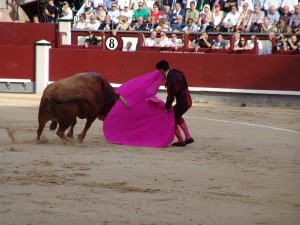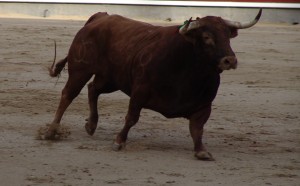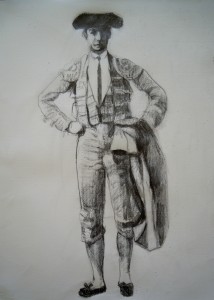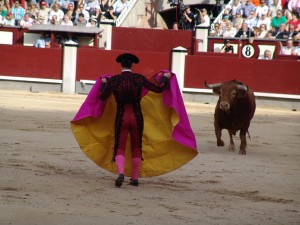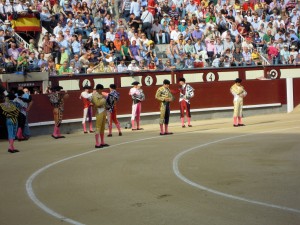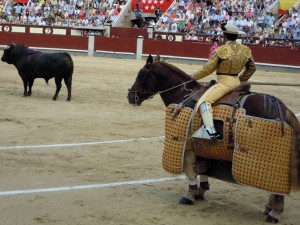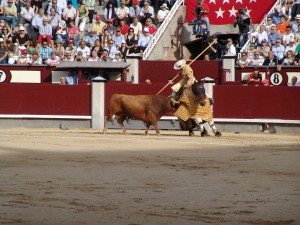The yearling calf , “becerro” (a one or two-year
old bull) is born, after nine months of gestation
within a group called “Punta”. During the first
nine months of life, it is fed with breast milk and it
stays along side of the other young, its mother and
the stud bull. Nine months later, the males separate
from the females into different groups. When the
animal turns two, it is no longer a yearling calf, but
rather a “Novillo”. The “Novillo”, under the
age of three is called “Eral” and the one who has
already turned three is called “Utrero”. Only when
the animal has turned four can it be called bull,
“Toro”.
The “Erales” (two or three-year old males)
undergo different trials in order to select the best
bulls capable of producing off-spring that are
“toros bravos”, fighting bulls. The “Tienta” is
the test that the stockbreeder conducts in order to
check the fighting spirit of the males and females.
The behavior of the first offspring in the bullring
will be the definitive test to determine if the stud
bull becomes part of the stockbreeder’s team or if it
must be sacrificed.
UNDERSTANDING BULLFIGHTING: TERCIO DE VARAS
Bullfighting with the “Muleta” requires bleeding the bull of its strength, brought
on by the actual bleeding that occurs when the lance punctures the bull’s back.
The Stage of Varas is the phase in which the bull is lanced by the Picador in order to
weaken it and prepare it for the Stage of Muleta (Suerte de Muleta).
The bleeding that depletes the bull of its energy must not be excessive but just
enough to calm its frenetic reactions.
The Stage of Varas is also a sort of test to gauge the fierceness of the bull. Only two
Picadores can be present in the bullring at the same time.
Two white circles painted on the sand in the ring create a boundary within which
the “Picadores” must remain.
UNDERSTANDING BULLFIGHTING: Bullfighter’s Costume
BULLFIGHTER’S COSTUME
La Montera
The headwear worn by the bullfighter and his team. They usually wear it
during the paseillo and the first two-thirds of the stages. The headwear is
usually made of astrakhan.
El Corbatín
A very narrow tie.
La Chaquetilla (The little jacket)
A short, stiff jacket with padded shoulders and armholes opened to allow
movement of the arms.
La Talequilla (The Pants)
Tight pants from the waist to below the knee, adjusted by cords or tassels
terminating in males. They are held up by suspenders.
Las Medias (Two pairs of stockings)
A white cotton interior stocking and a pink silk exterior stocking.
Las Zapatillas (The Shoes)
Flat, black colored shoes, adorned with a bow.
Understanding Bullfighting: Bullfighting With The Cape
The members of the matador’s team and the matador face the bull with the cape.
In the first two stages of the bullfight, the cape is used to “situar en suerte”, in
other words, to take the bull to an ideal spot to be jabbed by the Picador and to be
stabbed in the neck with the “Banderillas”. But the bullfighter also uses the cape
artistically. There is a wide range of ways of using the cape.
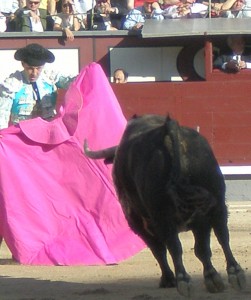
Bullfight tickets available on line: www.bullfightticketsmadrid.com
UNDERSTANDING BULLFIGHTING III: THE LOOSE BULL
As bullring’s staff show a banner with the name and weight of the first bull on it, one
of the “Alguacilillos” gives the key to the bullpens to the “Chulo de Toriles”
(the person in charge of opening the door from which the bull comes out into the
ring). Once the “Areneros” have cleaned the ring and everything is in order, the
president taking out the white kerchief, orders the first bull to be released.
After a short sound of the bugles, the door of the bullpen is opened and the bull goes
out into the arena.
UNDERSTANDING BULLFIGHTING: THE OPENING PROCESSION
Preceded by the “Alguacilillos”, the bullfighters and their teams go around the arena to the royal box to greet the President.
The three bullfighters do so in order of seniority. Seen from the front, the most veteran is to the right, the most novice is in the middle and to the left is the one with intermediate experience.
The “Banderilleros” (the ones who jab the bull with the “banderillas”) are situated also from
right to left, according to their seniority and they march behind the swordsman.
Following them, two by two, the Picadores and finally, the Mozos de Caballos (the horseman’s assistants), the “Areneros” (the men in charge
of the sand in the bullring), are followed by the mules and the “Mulilleros” (the men in charge of bringing the dead bulls out of the arena).
UNDERSTANDING BULLFIGHTING
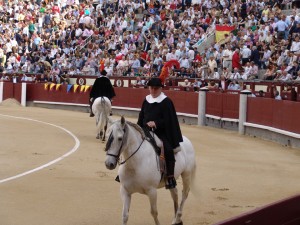 UNDERSTANDING BULLFIGHTING
UNDERSTANDING BULLFIGHTING
Did you know what is “El despejo” (The clearing)?
When bullfights took place in plazas, royal civil servants had to clear the people from the plazas before letting out the first bull. But nowadays when a bullfight takes place, in bullrings, clearing out the ring is a mere formality. In remembrance of this tradition today, two “Alguaciles” on horseback (persons responsible for opening the bull pen at the beginning of a bullfight) are dressed in the old style clothing from the time of Felipe IV. Their job is to go around the ring to make sure that it is devoid of people.
Once the “despejo” is finished, the “Alguaciles” greet the president,
nodding their heads and taking off their hats. Other duties of the “Alguaciles” include picking up the key from the bullpen, conveying and executing orders fromthe President, and giving out prizes to the bullfighters.
KINDS OF BULLFIGHTS
There are three kinds of bullfights:
1-Corrida de toros
The bullfighters fight on foot and must belong to the category of “Matador de
Toros” acquired in a ceremony called “Alternativa”
The “Alternativa” is a ceremony in which a bullfighter obtains the standing of
“Matador de Toros”. In “La suerte de Matar” the veteran bullfighter approaches
the novice with the sword and red cape (attached to a stick) in the left hand,
and they are revealed at the same time. The veteran then hands over the
sword and cape, as the novice turns over the cape to the veteran. Having
finished the exchange, the “Padrino“ (the bullfighter that conducts the
ceremony) usually congratulates or gives advice to the new swordsman or
the protégé and they end by greeting each other. The ceremony is repeated
with the second bull, but now the new swordsman is the one to give the
bullfighting effects to the veteran.
The animal fighting in bullfights must weigh at least 470 kg and be at least four
years old.
2-Corrida de novillos o Novillada
The swordsman are bullfighters on foot who haven’t yet received the title of
“Matador de Toros”. The animals used in this case are Novillos, bulls
that have not succeeded in demonstrating to a stockbreeder a certain level of
fierceness required in the bullfighting trials. They usually are younger than the
bulls fighting in a Corrida de Toros.
Corrida de Rejones o Rejoneo
The mounted bullfighter fights on horseback, assisted by a secondary bullfighters
on foot.
Bullfight season 2013
Feria de Otoño 2012 in Madrid
Bullfighting festival 4, 5, 6 and 7 October. 5:30pm
October 4th: Gomez del Pilar, Luis Gerpe y Gonzalo Caballero
October 5th: El Fundi, El Cid , Daniel Luque
October 6th: Sergio Aguilar, Ivan Fandiño, David Mora
October 7th: Fernando Robleño, Javier Castaño, Alberto Aguilar
Tickets avaliable on line: www.bullfightticketsmadrid.com